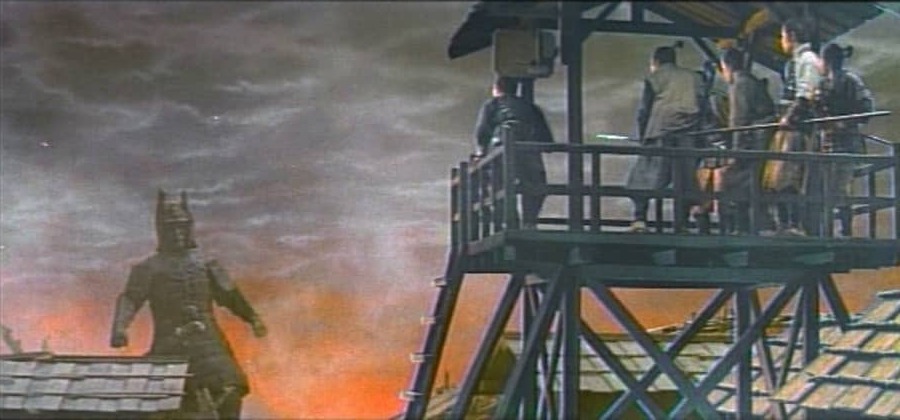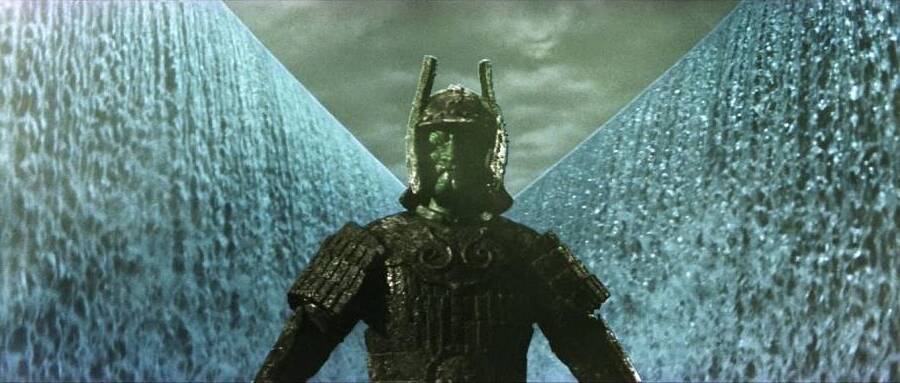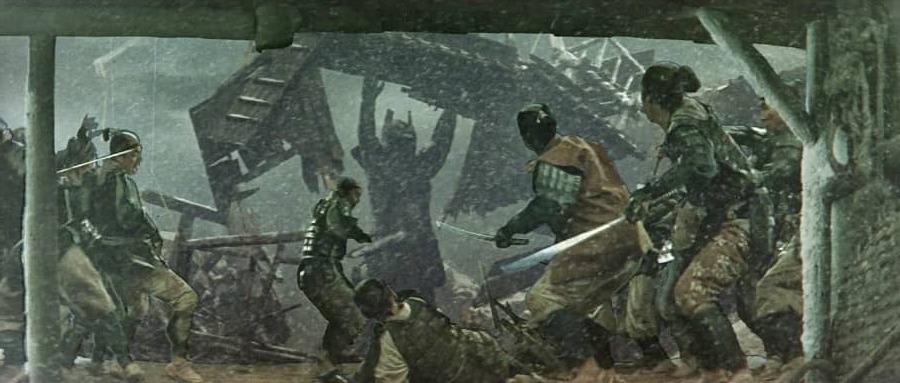Ellsworth’s Cinema of Swords: Daimajin Strikes Again!
Daimajin (or Majin the Monster of Terror)
In the menagerie of Japanese postwar film studios, the Toho Company was the 900-pound King Kong, known best for its crime and samurai films, including those of director Akira Kurosawa. Toho hit the international big time in 1954 with Godzilla, King of the Monsters, which, though inspired by King Kong and The Beast from 20,000 Fathoms, really counts as the first of the kaiju, or Japanese-style giant monster movies. Toho followed up in 1956 with Godzilla Raids Again, and expanded the franchise late in that year with Rodan.
Over the next several years Toho doubled down on the monster bet, adding Mothra, King Kong himself, and Ghidorah, and by the early Sixties other Japanese studios started getting in on the act. This included Daiei Films with their kaiju Gamera, who “starred” in seven features from 1965 through 1971. We know Daiei primarily for the Zatoichi series, which capitalized on their skill at churning out fair-to-exceptional historical samurai adventures mainly for the Japanese market. With Gamera, Daiei had a series that sold internationally as well, and they had the idea of mashing up their two most popular genres, kaiju and chambara, into a single series. (They weren’t alone in this idea: see also Toei’s The Magic Serpent.)
Samurai vs. a giant monster! Thus was born the Daimajin trilogy, which we’re taking a look at this week.
Daimajin (or Majin the Monster of Terror)
Rating: ****
Origin: Japan, 1966
Director: Kimiyoshi Yasuda
Source: Mill Creek Blu-ray
By the mid-Sixties, the Daiei studio was having success in two genres, giant monster movies and samurai adventure films. Why not cross the streams?
The earth is shaking, so the villagers overseen by the Hanabusa clan gather to conduct a midnight ritual to placate the Majin, the angry mountain demon. But a more prosaic danger is on the march: Samanosuke (Ryutaro Gomi), a ronin who’d been taken in by the Hanabusa, has masterminded a revolt, and his loyal cutthroats slay the clan chief and install Samanosuke as the new daimyo. However, the young son and daughter of the old daimyo escape with the help of the loyal samurai Kogenta (Jun Fujimaki). They are led by priestess Shinobu (Otome Tsukimiya) high onto the haunted mountain to take refuge in a cave guarded by a giant statue, the Daimajin god who keeps the mountain demon contained.
Ten years pass. Samanosuke has turned the village into a brutal slave labor camp, a stone quarry to build a fortress as a base for conquest. Meanwhile, the Hanabusa prince, Tadafumi (Yoshihiko Aoyama) and his sister, Kozasa (Miwa Takada), have grown to adulthood on the mountain under the guidance of Kogenta and Shinobu. Learning of the plight of the villagers, Kogenta sneaks down from the mountain to see what can be done, but is captured; Tadafumi attempts to free him and is captured as well. Shinobu warns Samanosuke that his sins will anger the mountain god, but he kills her and orders the Daimajin statue destroyed. When his men pound a great metal spike into the Daimajin’s forehead, the statue bleeds, there’s lightning and landslides, and chasms open in the earth, swallowing the attackers. And then things get bad.
The 25-foot-tall Daimajin, possessed by the furious mountain demon, marches on Samanosuke’s fortress. He’s a modest monster as kaiju go, owing more to the original King Kong than Godzilla, but he’s more than a match for Samanosuke’s samurai, despite their swords, muskets, catapults, chains, and flaming carts. The samurai are toast; the only question is, can the good guys persuade the monster to stand down before he destroys the village as well?
This mashup of the monster and samurai genres feels entirely natural: the direction easily changes gears from the spooky and supernatural to sharp samurai action, the acting is fine, and the cinematography is lush and colorful. Plus, there’s a clear moral: do not pound a metal spike into the forehead of a divine guardian statue. What more could you want?
Return of Daimajin (or Wrath of Daimajin)
Rating: ****
Origin: Japan, 1966
Director: Kenji Misumi
Source: Mill Creek Blu-ray
Immediate sequel! Lord Danjo of Mikoshiba (Takashi Kanda) is so cruel that his peasants are fleeing to the neighboring domain of Chigusa, a peaceful realm that shares Yagumo Lake with the benign domain of Nagoshi. In the middle of the lake is the island of the god that protects them both, embodied in a stone Daimajin statue. Right after a festival of peace between the two lake domains, Mikoshiba attacks Chigusa and slays its lord, but Chigusa’s son, Juro (Kojiro Hongo), who is betrothed to Princess Saiyuri of Nagoshi (Shiho Fujimura), escapes the assault. Assuming Juro has escaped across the lake, Danjo uses that as a pretext to conquer Nagoshi as well. Then, as a morale crusher, Danjo sends a team with explosive gunpowder charges to blow up the Daimajin statue, and all is gloom around Yagumo Lake.
But Juro and Saiyuri have both escaped to the island, and Juro is determined to lead a rebellion against Danjo. There follows nearly an hour of excellent samurai action, with midnight raids, secret passages, captures, escapes, and desperate sacrifices. But Danjo’s troops are just too numerous and ruthless, and eventually all the good guys are captured and tied to stakes for mass execution. Because it’s the wickedest thing he could do, Danjo has Lady Saiyuri tied to a stake to be burned alive, but she prays to their guardian god for aid and her maiden tears bring him to life.
This, of course, if what we’ve been waiting for. Daimajin, though blown to bits, rises whole from the lake and is possessed by a demon of vengeance. The lake waters separate to allow Daimajin to plod thunderously to shore! He walks through walls! He sneers at volleys of musket balls! He defies massed grappling hooks and exploding crates of gunpowder! He hurls boulders, summons lightning, and shoots fire bolts! It’s super gratifying.
Kenji Misumi, who directed six Zatoichi and four Lone Wolf and Cub features, is in total charge here, and he directs this mini-epic with a sure hand. You could fault it for being predictable, but you’d be wrong, because it delivers exactly what the audience is looking for.
Daimajin Strikes Again
Rating: ****
Origin: Japan, 1966
Director: Kazuo Mori
Source: Mill Creek Blu-ray
This is a boys’ adventure flick in which four plucky lads face cruel samurai and a giant monster. You say you don’t like child actors? Get over it!
In northern Japan, a team of loggers from the mountain village of Koyama has gone missing. One of them, wounded and dying, staggers back into town to report that the missing men have all been captured by samurai of the Arakawa clan and taken to a forced labor camp in Hell’s Valley. The wounded logger escaped and only made it home because he dared to cross the forbidden peak of the Majin, the mountain god. That route is the only way to free the others — but the villagers dare not try it.
Except, that is, for four young boys who are determined to save their fathers and brothers. With just a few supplies, they set off to climb the mountain of the Majin and make their way to Hell’s Valley to free the captives. There’s a good half hour of Kids vs. Nature in spectacular scenery, struggling until they reach the peak and find the statue of Daimajin; awed, they honor it and pay their respects, and in return the mountain god sends an avatar, a great hawk, to watch over them. And they’re going to need help, because Lord Arakawa (Toru Abe) has sent a squad of his nastiest samurai to close off the mountain approach.
Meanwhile, in Hell’s Valley, the Koyama loggers are being worked to death in a foul environment of boiling springs and noxious gases, mining sulfur so the Arakawa can make industrial quantities of gunpowder with which to conquer their neighbors. The Majin is angered and wreaths his mountain in a sudden snow storm, but that just enables the nasty samurai to follow the tracks of the plucky lads. Trapped, one of them sacrifices himself to the mountain god in a plea for aid, and the Daimajin statue animates, filled with the spirit of a demon of vengeance. The statue marches on Hell’s Valley, bringing a blizzard with it, and not even artillery can save Lord Arakawa when, after three movies, Daimajin finally draws his catastrophic sword.
The Daiei Film studio shot all three Daimajin films back to back and then released them a few months apart throughout 1966. Kazuo Mori, one of the regular Zatoichi directors, found a way to keep the formula fresh by turning the third film into a kids’ adventure, and very successfully, too. It’s one of a kind.
The previous installments in the Cinema of Swords are:
Olivia de Havilland — First Queen of the Swashbucklers
Goofballs in Harem Pants
Disney’s Early Swashbucklers
‘50s Vikings – Havoc in Horned Helms
Laughing Cavaliers
Charming and Dangerous: Douglas Fairbanks, Jr.
Eleven Samurai: Early Chambara Classics
Beyond Captain Blood: Three by Sabatini
3 Musketeers + 1 Long Nose
Louis Hayward, Everyman with a Sword (Part 1 of 2)
Days of Technicolor Knights
Louis Hayward, Everyman with a Sword (Part 2 of 2)
Laurence Olivier, Swashbuckler?
Tony Curtis Goes Yonda
The 7th Voyage and Its Children
The Good, the Bad, and Mifune
The First British Invasion
Wholesome Buccaneers (Pt. 1)
The Tale of Zatoichi
The Sign of the Z!
Gallic Gallantry
Classic, Mythic and Epic
The Exuberant Excess of Sixties Vikings
Tyrone’s Typecast Troubles
Not-So-Wholesome Buccaneers
LAWRENCE ELLSWORTH is deep in his current mega-project, editing and translating new, contemporary English editions of all the works in Alexandre Dumas’s Musketeers Cycle, with the fourth volume, Blood Royal, just published by Pegasus Books in the US and UK. His website is Swashbucklingadventure.net.
Ellsworth’s secret identity is game designer LAWRENCE SCHICK, who’s been designing role-playing games since the 1970s. He now lives in Dublin, Ireland, where he’s writing Dungeons & Dragons scenarios for Larian Studios’ Baldur’s Gate 3.



Another Ellsworth’s Cinema of Swords? Zowie!
I have only heard of, but never seen a Daimajin movie. Gonna have to do something about that! I’ve always liked the work done by Daiei Films and it sounds like their people came through again with this series.
But why do you feel it necessary to mention the first film’s Moral: “Do not pound a metal spike into the forehead of a divine guardian statue” It’s not like the guys in my RQ campaign would ever do anything like that. More than once…
Thank you, Mr. Ellsworth.